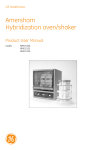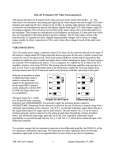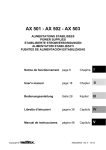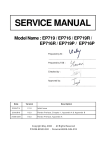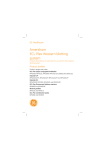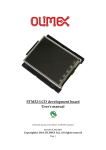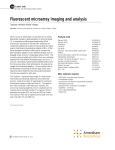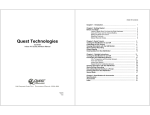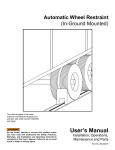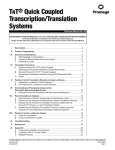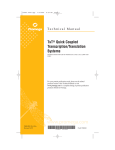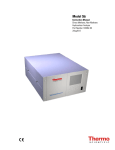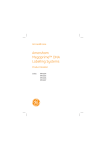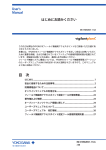Download マニュアル Hybridization oven/shaker
Transcript
user manual hybridization Hybridization oven/shaker RPN2511 Underwriters Laboratories Inc. Listed, #E195497 Hybridization Oven/Shaker RPN2511 Contents 1.0 Introduction 2.0 Specifications 3.0 Setting up the Hybridization Oven/Shaker 4.0 Hybridization using the platform shaker 5.0 Hybridization using the rotisserie 6.0 Maintenance/care/cleaning of the instrument 7.0 Wiring diagram 8.0 Troubleshooting guide Appendices: Associated GE Healthcare products IMPORTANT: Please read the separate instructions for use before operating the GE Healthcare Hybridization Oven/Shaker to familiarize yourself with its electrical installation and safety precautions. 1 Products for electrophoresis 2 Hybond membranes for nucleic acid and protein applications 3 Systems for radioactive labelling of nucleic acids 4 Radioactive nucleotides 5 Systems for non-radioactive labelling and detection 6 Products for autoradiography and chemiluminescent detection 7 Hybridization products 8 Radiation safety products 3 1.0 Introduction One of the most widely used techniques in the molecular biology field is the immobilization of DNA and RNA onto a solid support membrane and subsequent hybridizations with a specific single stranded probe, labelled to facilitate its detection. Using the GE Healthcare Hybridization Oven/Shaker ensures that the temperature and shaking/rotation frequency, and hence the stringency of hybridization and washing steps are rigidly controlled. This enables rapid and reproducible probing of nucleic acids, and proteins immobilized on nylon and nitrocellulose membranes. The GE Healthcare Hybridization Oven/Shaker is a multipurpose instrument combining accurate temperature control with a choice of interchangeable hybridization modes: l Variable speed rotisserie: holding 7 x 35 mm or 2 x 70 and 2 x 35 mm hybridization bottles. l A variable speed platform shaker for 'box’ hybridizations, depurination, denaturation and neutralization steps. The instrument is: l Economical: bottle hybridization minimizes probe volumes, reducing reagent volumes and enhancing signal intensity. l Precise: stringency of hybridization and washing steps are rigidly controlled, ensuring reproducible results. l Sensitive: validated protocols ensure optimal hybridization and washing steps, enhancing multiple reprobing when using HybondTM membranes. l Safe: the double-glazed polycarbonate/acrylic door offers excellent thermal insulation whilst minimizing radiation exposure. l Convenient: small foot-print maximizes the use of limited laboratory space. The instrument is suitable for use in conjunction with radiolabelled probes using Rapid-hyb TM buffer, non-radioactive nucleic acid labelling and detection systems such as AlkPhos DirectTM, and protein labelling and detection systems including ECLTM and ECL Plus TM. Some protocols for use with these applications are included in section 6. 4 2.0 Specification Overall dimensions Height: Depth: Width: 9.5 " 10.0 " 11.25 " (24.0 cm) (25.0 cm) (28.5 cm) Height: Depth: Width: 8.0 " 9.0 " 10.0 " (20.0 cm) (23.0 cm) (25.0 cm) Weight: 24 kg Capacity (nominal): 18 litres Temperature range: Ambient plus 5 oC–80 oC Temperature precision: +/- 0.5 C Temperature fluctuation: +/- 0.1 °C (@37°C) Power rating: 250 W Over temperature cut-out: 1 C over set temperature Temperature variation: <0.25 oC Rotisserie speed: 2–10 rev/min Shaker platform speed: 5–70 strokes/min Total angle of tilt: 4o or 10o angle Oven dimensions o o Electrical Nominal Voltage/Hertz/Amp Product code 230 V/50 Hz/3.1 A 110 V/120 V/60 Hz/4 A 100 V/50/60 Hz RPN2510 RPN2511 RPN2512 Each instrument is supplied with 1 rotisserie (RPN2514), 6 hybridization bottles (RPN2516) and an instruction manual. Accessories Rotisserie, holds 7 x 35 mm hybridization bottles RPN2514 Rotisserie, holds 2 x 70 mm and 2 x 35 mm hybridization bottles RPN2515 Hybridization bottle, 230 x 35 mm (For rotisserie RPN2514, pack of 6) RPN2516 Hybridization bottle, 150 x 35 mm (For rotisserie RPN2514, pack of 6) RPN2517 Hybridization bottle, 230 x 70 mm (For rotisserie RPN2515, pack of 2) RPN2518 Hybridization mesh, 1 roll 21.5 cm x 10 m RPN2519 5 3.0 Setting up the Hybridization Oven/Shaker 3.0.1 Remove all packaging and place the Hybridization Oven/Shaker on a level working surface, ensuring that there is sufficient room above the instrument to allow the door to be opened fully. 3.0.2 Plug the female end of the power cable into the Hybridization Oven/Shaker. 3.0.3 Connect the power cable to a suitably grounded electrical outlet. The correct operating voltage of the Hybridization Oven/Shaker is found on the product information label on the rear of the instrument. 3.0.4 Turn the Mains ON/OFF switch (1 on Fig 1) to the ON position. 3.0.5 The GE Healthcare Hybridization Oven/Shaker is now ready for use. 1 2 7 3 8 4 5 9 1. Mains ON/OFF switch 6. Oven OVER TEMP dial 2. Temperature ON/OFF switch 7. Rotisserie/shaker ON/OFF switch 3. Temperature SET switch 8. Rotisserie/shaker speed selector dial 4. Temperature SET dial 9. Oven FAULT LED 6 5. Digital temperature display 3.1 Fig 1. Diagram of instrument control panel 3.2 Setting the oven temperature 3.2.1 Press the Mains ON/OFF switch (1, see Fig 1) to the ON position. 3.2.2 Press the Temperature ON/OFF switch (2) to the ON position. 3.2.3 Press the Temperature SET switch (3), at the same time rotate the Temperature SET dial (4) until the required temperature is shown on the digital display (5). 3.2.4 Release the Temperature SET switch (3). 3.2.5 Rotate the Oven OVER TEMP dial (6) to the SET temperature +5 oC. NOTE: The automatic temperature cut-out operates at 1 o C above the SET temperature, to ensure that the desired temperature is maintained at all times. The OVER TEMP setting acts as an instrument fail safe mechanism. Should the OVER TEMP setting be reached, the red FAULT LED (9) will light up denoting a fault in the temperature control system. 3.2.6 6 The oven will now automatically heat up the the SET temperature. 3.3 Setting up the rotisserie The rotisserie is installed in the Hybridization Oven/Shaker during transit. To use the rotisserie for bottle hybridization, the following procedure should be adopted: 3.3.1 Lift up the oven door to its fullest extent to allow complete access to the oven interior. 3.3.2 Lift the rotisserie vertically out of the oven and place on the bench. 3.3.3 Place the membranes to be hybridized in to the required number of hybridization bottles. Using the rotisserie as a stand for the bottles, place the bottles into the rotisserie, pushing them down as far as they will go. NOTE: Always ensure that the weight is evenly distributed on both sides of the rotisserie. Place an empty hybridization bottle into the other side of the rotisserie as a counterbalance if necessary. 3.3.4 Place the rotisserie into the voen onto the rotation mechanism, ensuring that the serrated bands at either end of the rotisserie locate onto the steel cogs of the rotation mechanism at the rear of the oven. The plastic flanges of the rotisserie locate on to the small wheels on the oven floor. Close the oven door. 3.3.5 Ensure that the Mains ON/OFF switch (1) is in the ON position and that the desired temperature has been set (see section 4.2). 3.3.6 Turn the Rotisserie/Shaker ON/OFF switch (7) to the ON position. 3.3.7 Turn the Rotisserie/Shaker speed selector dial (8) clockwise until the desired rotation speed is reached (allowable values are 2–10 rpm). The rotisserie will now start to rotate at the set rate. 3.3.8 When hybridization is complete turn the Rotisserie/Shaker ON/OFF switch (7) to the OFF position. 3.4 Setting up the platform shaker During transit, the platform is stored vertically at the rear of the oven chamber. It can remain in this position whilst the rotisserie is in use. To use the platform shaker for ‘sandwich box’ hybridizations, the following procedure should be adopted: 3.4.1 Open the oven door to its fuIlest extent, Iift the rotisserie vertically and store in a safe place. 3.4.2 Lift the platform by its handle (A, see figure 2) from its storage position, slide it forward and locate it on the rocking mechanism by placing the side pegs (8) of the platform into the retainers (C) on the side walls of the oven chamber. This action seats the nylon blocks (D) on the underside of the platform on to the pegs (E) protruding from the rocker mechanism at the rear of the oven. 3.4.3 Place the box in which the hybridization is being performed on to the shaker platform and close the oven door. 3.4.4 Ensure the Mains ON/OFF switch (1, see figure 1) is in the ON position and that the desired temperature has been set (see section 4.2). 3.4.5 Turn the Rotisserie/Shaker ON/OFF switch (7) to the ON position. 3.4.6 Rotate the Rotisserie/Shaker speed selector dial (8) clockwise, until the desired shaker speed is reached. Allowable values are 5–70 strokes per minute. The shaker platform will now oscillate at the set rate. 7 3.4.7 When hybridization is complete, turn the ON/OFF switch (7) to the OFF position. NOTE: The shaker platform can be operated at a choice of tilt angles, 4o or 10o The larger the angle, the greater the vertical movement of the platform at the end of each stroke, and hence the greater the agitation of the contents of the box. This facility allows further fine-tuning of the rocking motion of the shaker platform in addition to controlling the shaker speed. The tilt angle is controlled by the position of the pegs in the rocker mechanism, which is attached to the rear of the spill tray. To alter the tilt angle, unscrew the spill tray by rotating the nylon retaining screws anti-clockwise. Lift out the spill tray. Remove the two pegs (E in figure 2) and screw in to the appropriate position in the rocker mechanism. Figure 3 below, shows the relative positions of each hole and the tilt angle to which they correspond. Fig 2. Hybridization oven drive components On completion, ensure that the spill tray is repositioned correctly and screwed down securely. On starting the shaker, the drive shaft will automatically re-engage itself. This may take a few revolutions of the drive mechanism. 4 o tint central spindle 10 o tint Fig 3. Adjustment of angle of tilt of platform shaker 8 4.0 Hybridization using the platform shaker The Hybridization Oven/Shaker is compatible with the hybridization technologies available from GE Healthcare. These include radioactive hybridizations using Rapid hyb buffer and the range of non-radioactive systems for the labelling and detection of proteins and nucleic acids (see appendix 1). When using the platform shaker the hybridization and washing conditions recommended in the appropriate GE Healthcare literature should be used. The following protocol therefore provides a guideline. For specific hybridization times and temperatures, refer to the relevant protocol booklet. 4.0.1 Prepare blots as recommended in the appropriate Hybond protocol booklet. 4.0.2 Set the oven temperature and over temperature values as described in section 4.2. 4.0.3 Place the membrane in a suitable box (or bag) and cover with sufficient prehybridization buffer to ensure that the entire surface of the membrane is covered. Recommended volume: surface area ratio is given in most protocol booklets. Seal the box (or bag) securely. 4.0.4 Place the box (or bag) on the platform, set the oscillation speed to 30 strokes/min and prehybridize for the required length of time. 4.0.5 Remove the box (or bag) from the oven and carefully add the labelled single stranded probe (denaturation may be required post labelling refer to the appropriate protocol booklet) to the prehybridization buffer. NOTE: Do not pipette the probe solution directly on to the membrane as this may cause localized background. 4.0.6 Reseal the box (or bag) securely, replace it on the platform and hybridize for the required length of time. 4.0.7 Remove the membranes and place in a clean box containing the first stringency wash solution. 4.0.8 Increase the oscillation speed of the platform to 60 strokes/min. Carry out the recommended washing protocol at the appropriate temperature and for the appropriate times. 9 5.0 Hybridization using the rotisserie Several advantages are associated with performing hybridizations in bottles, namely those of safety and economy as outlined in the introduction. However, the use of bottles for hybridizations and washing procedures requires certain adaptations to standard protocols. 5.1 Assembly of membranes into bottles 5.1.1 Add approximately 20 ml 2x SSC buffer into the hybridization bottle. The rotisserie acts as a convenient bottle stand. 5.1.2 Pre-wet the membrane in 2x SSC buffer and loosely roll it up. 5.1.3 Insert the rolled up membrane into the bottle and replace the cap. Ensure that the cap is screwed on securely, (hand tight plus a quarter turn). DO NOT OVERTIGHTEN, or the thread of the cap can be damaged, leading to leakages. NOTE: If placing several small blots into one bottle, prewet the membranes as above, and space them out along the length of the bottle with forceps. 5.1.4 Place the bottle on a flat surface and roll it gently in the opposite direction to that which the membrane is coiled. This rolling action causes the membrane to uncoil, so lining the inner surface of the bottle. NOTE: The use of a mesh in bottle hybridizations to ensure uniform contact between the membrane surface and the buffer has been recommended. However, studies at GE Healthcare laboratories using a wide range of hybridization mesh technologies demonstrate a resulting loss of sensitivity due to partial absorption of the probe into the mesh. A nylon mesh (RPN2519) is available as an optional extra, as it can facilitate easier handling of a number of blots and the more fragile nitrocellulose membranes. These handling advantages should be considered against the potential loss of sensitivity before use. When a hybridization mesh is used in conjunction with the membrane, the following procedure should be adopted: 5.1.5 Pre-wet the mesh alongside the membrane in 2x SSC buffer and place the prewetted membrane on top of the mesh. The mesh should be slightly larger than the blot in all dimensions. Roll both up together, with the mesh on the outside of the membrane, and insert into the bottle as described above (6.1.4). 5.2 Hybridization 10 5.2.1 Set the required oven temperature and over temperature, (as detailed in section 4.2). 5.2.2 Discard the 2x SSC, used in the bottle to unroll the membrane, and replace with prehybridization buffer. Recommended volumes are provided in most GE Healthcare protocol booklets. Generally a minimum of 10– 15 ml per 20 x 20 cm blot is advised. Seal the bottle, avoiding overtightening. 5.2.3 Place the hybridization bottle(s) into the rotisserie (as detailed in section 4.3) add counterbalance bottles if necessary. Place the rotisserie into the oven so that the bottles are rotating in the same direction as the membrane is rolled, see Figure 4 overleaf. rotation of membrane Fig 4. Rotation of rotisserie 5.2.4 Prehybridize the membrane for the specified length of time at a rotisserie speed of 4 rpm. 5.2.5 Following prehybridization, turn off the rotisserie, remove the rotisserie from the oven. Add the labelled probe to the buffer, either by removing an aliquot of the buffer, adding the probe and returning the aliquot to the bottle; or by adding the probe directly into the bottle, avoiding the membrane. 5.2.6 Hybridize for the specified length of time at a rotisserie speed of 4 rpm. 5.3 Membrane washing procedures Membranes can either be removed from the hybridization bottles and washed in a box on the platform shaker (this is a more efficient procedure), or the washing procedure may be carried out in the bottles. If the platform shaker is used, follow the standard washing procedure mentioned in the appropriate protocol booklet. If bottles are to be used it is necessary to modify the standard washing procedure. Outlined in this section are the optimized washing protocols for radioactive hybridizations and non-radioactive based hybridizations. Radioactive Hybridizations 5.3.1 Carefully drain off the hybridization buffer, rinse the bottle and the membrane thoroughly with 2x SSC and discard. 5.3.2 Perform the following stringency washes in large volumes (100 ml minimum) of the following solutions, at a rotisserie speed of 8 rpm: 2 x 10 min with 2x SSC, 0.1% SDS at 65 °C 1 x 15 min with 1x SSC, 0.1% SDS at 65 °C 2 x 10 min with 0.1x SSC, 0.1% SDS at 65 °C NOTE: This last step is a high stringency wash and should be omitted if related sequences are to be probed. (More washes over the same time period for each stringency condition can improve background). 5.3.3 Remove the membrane from the bottle, drain off excess stringency wash, TM wrap in SaranWrap and autoradiograph. 11 AlkPhos Direct Hybridizations 5.3.4 Drain off the hybridization buffer, rinse the bottle and the membrane thoroughly with primary wash buffer and discard. 5.3.5 Perform the following stringency washes in large volumes (100 ml minimum) of the following solutions, at a rotisserie speed of 8 rpm: 3 x 10 min with primary wash buffer solution at 55 °C 3 x 5 min with secondary wash buffer at room temperature NOTE: The room temperature washes can be achieved by switching off the oven and leaving the door open whilst performing the washes or by allowing the oven to cool down to room temperature before performing the final washes. 5.3.6 Remove the membrane from the bottle and detect using the standard procedures outlined in the protocol booklet. Gene Images Random Prime Hybridizations 5.3.7 Drain off the hybridization buffer, rinse the bottle and the membrane thoroughly with 2x SSC and discard. 5.3.8 Perform the following stringency washes in large volumes (100 ml minimum) of the following solutions, at a rotisserie speed of 8 rpm: o 2 x 10 min with 1x SSC, 0.1% SDS at 60 C o 1 x 10 min with O.1x SSC, 0.1% SDS at 60 C 5.3.9 Remove the membrane from the bottle and detect using the standard procedures outlined in the booklet. The detection procedure may be carried out using the shaker mode of the Hybridization Oven/Shaker. NOTE: The room temperature washes can be achieved by switching off the oven and leaving the door open whilst performing the incubations or by allowing the oven to cool down to room temperature. 12 6.0 Maintenance/care/cleaning of the oven/shaker The GE Healthcare Hybridization Oven/Shaker is designed to provide trouble-free operation. The base of the oven and the shaker tray act as a spills tray and will contain any spillage that occurs during hybridization and washing procedures. To ensure lasting operation the following instructions should be followed: ALWAYS DISCONNECT THE HYBRIDIZATION OVEN/SHAKER FROM THE ELECTRICAL SUPPLY BEFORE CLEANING OR DRYING THE INSTRUMENT. 1. Any leakage from the hybridization bottles or the sandwich boxes should be cleaned up immediately. Do not allow any liquids to enter the drive mechanism. 2. Wipe away any liquids from inside and outside of the unit using soap and water with a soft cloth or sponge. 3. Do not allow chemicals to remain on unit surfaces. 4. Never clean unit with abrasive pads or cleaners. 5. Never clean unit with acetone or chloroform. 13 7.0 14 Wiring diagram 8.0 Troubleshooting guide This section briefly summarizes some of the potential problems encountered during membrane hybridizations. More complete troubleshooting guides are supplied in the pack leaflet that accompany each product. Symptom Cause Remedy Membrane curling up in hybridization Incorrect orientation of Ensure membrane is rolled up in the bottle bottle in rotisserie same direction as the bottle is rotating (see section 6.2) High background Probe concentration too high 32 Reduce probe concentration Unincorporated P nucleotides Remove unincorporated nucleotides not removed eg. using AmprepTM C18 column Insufficient blocking Use recommended hybridization buffer or extend prehybridization time Insufficient washing Increase number of buffer changes during the washing stage or increase stringency of final wash Weak signal No transfer from gel to Load extra lanes with control DNA. membrane Transfer can be checked by restaining gel with ethidium bromide. If large DNA fragments are detected poorly, use a depurination step (0.25 M HCI) Probe not labelled Check probe labelling before hybridization. See protocol in probe labelling booklet Probe not denatured Boil probe for 5 minutes before adding to hybridization buffer Low specific activity of probe Review labelling conditions Washes too stringent Increase buffer salt concentration and decrease temperature Patchy backgrounds Hybridization buffer or wash Increase volume of hybridization wash solution not evenly covering or solutions or use mesh (see section membrane 6.1.4) Damaged membrane Handle membrane carefully with forceps High background around edge of membrane Damaged membrane Use clean scissors or a sharp scalpel to cut membrane 15 16 Appendix 1. Products for electrophoresis 17 Appendix 2. Hybond membranes for nucleic acid applications 18 Appendix 3. Radioactive labelling systems 19 Appendix 4. Radioactive nucleotides Compound Concentration Specific activity TBq/mmol Ci/mmol Redivue product code Standard product code Pack size (see key) 10 mCi/ml ~6000 ~3000 ~800 ~400 ~6000 ~3000 ~800 ~400 ~3000 ~800 ~400 ~3000 ~800 ~400 ~3000 ~400 ~3000 ~800 ~400 ~800 ~3000 ~400 ~3000 ~800 ~400 ~800 >5000 >5000 ~3000 ~3000 ~30 ~3.0 ~3.0 >5000 >5000 ~3000 ~30 ~3000 ~1000 AA0074 AA0004 AA0084 AA0064 AA0075 AA0005 AA0085 AA0065 AA0006 AA0086 AA0066 AA0007 AA0087 AA0067 PB10474 (a) PB10204 (a) PB10384 (a) PB10164 (a) PB10475 (a) PB10205 (a) PB10385 (a) PB10165 (a) PB10206 (a) PB10386 (a) PB10166 (a) PB10207 (a) PB10387 (a) PB10167 (a) PB10200 (a) PB10160 (a) PB10202 (a) PB20382 (b) PB10162 (a) PB40382 (e) PB10201 (a) PB10161 (a) PB10203 (a) PB20383 (b) PB10163 (a) PB40383 (e) PB10218 (a) PB218 (c) PB10168 (a) PB168 (c) PB10132 (a) PB108 (c) PB170 (d) PB10244 (a) PB10235 (a) PB10233 (a) PB171 (d) PB10208 (a) PB10282 (g) 1, 2 & 3 1, 2 & 3 1, 2 & 3 1, 2 & 3 1, 2 & 3 1, 2 & 3 1, 2 & 3 1, 2 & 3 1, 2 & 3 1, 2 & 3 1, 2 & 3 1, 2 & 3 1, 2 & 3 1, 2 & 3 1, 2 & 3 1, 2 & 3 1, 2 & 3 1, 2 & 3 1, 2 & 3 3 1, 2 & 3 1, 2 & 3 1, 2 & 3 1, 2 & 3 1, 2 & 3 3 1, 2 & 3 1, 2 & 3 1, 2 & 3 1, 2 & 3 1, 2 & 3 1, 2 & 3 1, 2 & 3 1&3 1&3 1&3 1, 2 & 3 1, 2 & 3 1&3 32 P [α- 32 P]dATP [γ- 32P]GTP 32 [α- P]ddATP 10 mCi/ml 2 mCi/ml 2 mCi/ml 10 mCi/ml 10 mCi/ml [α- 32 P]ATP [ 32P]pCp [ 32P]NAD 2 mCi/ml 10 mCi/ml 10 mCi/ml ~220 ~110 ~30 ~15 ~220 ~110 ~30 ~15 ~110 ~30 ~15 ~110 ~30 ~15 ~110 ~15 ~110 ~30 ~15 ~30 ~110 ~15 ~110 ~30 ~15 ~30 >185 >185 ~110 ~110 ~1.11 ~0.11 ~0.11 >185 >185 ~110 ~1.11 ~110 ~37 10 mCi/ml 10 mCi/ml 20 mCi/ml 37–110 37–110 37–110 1000–3000 1000–3000 1000–3000 AH9968 AH9904 BF1000 (a) BF1001 (a) BF1002 (a) 1, 2 & 3 1, 2 & 3 1 [ S]dATPαS 10 mCi/ml 10 mCi/ml 10 mCi/ml SJ1304 SJ304 SJ264 SJ1305 SJ305 SJ265 SJ1334 (h) 1&3 1&3 1&3 1&3 [ 35S]dATPαS >1000 ~600 ~400 >1000 >600 ~400 >1000 AG1000 AG1001 AG1002 [ 35S]dCTPαS >37 ~22 ~15 >37 ~22 ~15 >37 32 [α- P]dCTP 10 mCi/ml [α- 32 P]dGTP 10 mCi/ml [α- 32 P]dTTP 10 mCi/ml [α- 32 P]ATP 10 mCi/ml 32 [α- P]CTP [α- 32 P]GTP 32 [α- P]UTP [γ- 32P]ATP 10 mCi/ml 20 mCi/ml 40 mCi/ml 10 mCi/ml 10 mCi/ml 20 mCi/ml 40 mCi/ml 10 mCi/ml 2 mCi/ml AA0003 AA0018 AA0068 P 33 [γ- 32P]ATP [α- 32 P]dATP [α- 32 P]UTP 35 S 35 20 1&3 Compound Concentration 35 [ S]ATPαS [ 35S]CTPαS [ 35S]UTPαS [ 32S]ATPγS 10 40 10 20 10 40 10 10 mCi/ml mCi/ml mCi/ml mCi/ml mCi/ml mCi/ml mCi/ml mCi/ml Specific activity TBq/mmol Ci/mmol >37 >1000 ~22 ~600 ~15 ~400 >37 >1000 ~30 ~800 >37 >1000 >37 >1000 ~15 ~400 ~30 ~800 >37 >1000 ~22 ~600 Redivue product code Standard product code SJ1300 SJ300 SJ260 SJ1302 SJ40382 (f) SJ1303 SJ603 (i) SJ263 SJ40383 (f) SJ1318 SJ318 Pack size (see key) 1&3 3 1&3 1&3 1&3 3 1&3 1 NOTE: Redivue 32P- and 33P-nucleotides contain dye and stabilizer in formulation A. All 35S-nucleotides are supplied in stabilized aqueous solution (containing 20 mM DTT) at 370 MBq/ml, 10 mCi/ml except where stated. Formulation decoder A B C D E F G H I Stabilized aqueous solution (containing 5 mM 2-mercaptoethanol) at 370 MBq/ml, 10 mCi/ml Stabilized aqueous solution (containing 5 mM 2-mercaptoethanol) at 740 MBq/ml (SP6/T7 grade) Ethanol: water (1.1) now supplied in the CDC container at 74 MBq/ml, 2 mCi/ml Aqueous solution at 74 MBq/ml, 2 mCi/ml Stabilized aqueous solution at 1.5 GBq/ml, 40 mCi/ml (SP6/T7 grade) SP6/T7 Grade supplied at 1.5 GBq/ml, 40 mCi/ml Stabilized aqueous solution pH6.0 Contains no DTT (in situ grade) Stabilized aqueous solution (containing 20 mM DTT at 740 MBq/ml, 20 mCi/ml (SP6/T7 grade) Pack size key 1: 9.25 MBq, 250 µCi 2: 18.5 MBq, 500 µCi 3: 37 MBq, 1 mCi 21 Appendix 5. Non-radioactive labelling and detection systems 22 Appendix 6. Products for autoradiography and chemiluminscent detection Hyperfilm – high performance autoradiography films Size Pack size Hyperfilm MP: multipurpose film autoradiography film 18 x 24 cm 18 x 43 cm 30 x 40 cm 35 x 43 cm 35 x 43 cm 20 cm x 25 m 18 x 24 inches 5 x 7 inches 8 x 10 inches 8 x 10 inches 10 x 12 inches 25 sheets 25 sheets 25 sheets 25 sheets 75 sheets 1 roll 75 sheets 25 sheets 25 sheets 75 sheets 25 sheets RPN6K RPN36K RPN7K RPN8K RPN30K RPN34K RPN1675K RPN1676K RPN1677K RPN1678K – Hyperfilm ECL: for use with enhanced chemiluminescence RPN2103K – RPN2104K – – – RPN3103K RPN1674K RPN2114K RPN3114K RPN1681K Hypercassette TM – cassettes for autoradiography and light detection Size Code (standard) Code (deep) 18 x 24 cm RPN11642 RPN1628 24 x 30 cm RPN11643 30 x 40 cm RPN11644 RPN1627 35 x 43 cm RPN11645 18 x 43 cm RPN11646 20 x 40 cm RPN11647 5 x 7 inches RPN11648 8 x 10 inches RPN11649 RPN1629 10 x 12 inches RPN11650 HyperscreenTM – intensifying screens for 32P and 1251 autoradiography Size Code Quantity 18 x 24 cm RPN1662 1 pair 24 x 30 cm RPN1663 1 pair 30 x 40 cm RPN1664 1 pair 35 x 43 cm RPN1665 1 pair 18 x 43 cm RPN1666 1 pair 20 x 40 cm RPN1667 1 pair 5 x 7 inches RPN1668 1 pair 8 x 10 inches RPN1669 1 pair 10 x 12 inches RPN1670 1 pair Miscellaneous Product name HypertorchTM Battery powered LED darkroom torch, pack of 3 Sensitize TM Optimized preflash system TrackerTape TM An adhesive, waterproof tape that phosphoresces to give a permanent written image on film. For use with radioactive or chemiluminescent emissions Code RPN1620 RPN2051 RPN2050 23 Appendix 7. Hybridization products Product name Rapid-Hyb buffer Rate enhanced hybridization buffer for use with radiolabelled nucleic acid probes Hybridization buffer tablets Each tablet makes 10 ml of hybridization buffer for use with any nucleic acid probe Pack size Product code 125 ml 500 m 100 tablets RPN1635 RPN1636 RPN131 Appendix 8. Radiation safety products 32 For the safe handling and storage of P Product code Pack description Beta starter pack – comprehensive shielding and containment package for 32 P users RPN2052 1 pack Beta safety screen, 15 o – ideal when working seated at the bench RPN1536 1 screen Beta safety screen, 45 o – when working standing up RPN1537 1 screen Beta side/rear screen – use vertically or horizontally to protect your colleagues RPN2034 1 screen Beta workbox – for the storage of low level radioactive working RPN1539 1 box Beta workbox insert – for the storage of 32 microcentrifuge tubes RPN1540 1 insert Beta safe storage box – holds 3 tube racks or workstations RPN1541 1 box Beta work tank – beta workstation, gives 360 o protection from beta radiation RPN2033 1 worktank Beta heavy duty tube rack – 35 mm acrylic with 4 tube holes RPN1543 1 rack Beta waste safe – safe short-term storage of low activity waste awaiting disposal 400 x 240 x 220 mm 10 mm acrylic RPN1532 1 safe Beta midi waste safe – designed to hold standard 'sharps' 315 x 225 x 235 mm RPN2038 1 safe Beta mini waste safe – compatible with the Beta work tank 150 x 120 x 100 mm RPN2039 1 safe Beta tip safe – mini waste safe with hinged lid for safe pipette tip disposal 150 x 150 x 150 mm RPN2081 1 safe Beta tip safe plastic bags – disposable draw-string plastic bags RPN2083 pack of 25 Beta pipette guard – designed for use with Gilson Pipetman range of pipettes for use with the P20/100 size for use with the P200 size for use with the P1000 size set of beta pipette guards (RPN1544, RPN1545, RPN1546) RPN1544 RPN1545 RPN1546 RPN1556 1 1 1 3 guard guard guard guards RPN1534 RPN1533 RPN2042 RPN2043 RPN2063 RPN2083 RPN2093 1 1 1 1 1 1 1 tray tray tray tray tray tray tray Beta shielding is manufactured from 10 mm heavy gauge, optical quality acrylic which effectively absorbs 3 2P beta particles TM Radiation safety accessories Safety tray – a defined working area for bench radioactive work 685 x 455 mm 685 x 455 mm (white**) 685 x 535 mm 530 x 330 mm 1120 x 535 mm 565 x 535 mm 455 x 255mm **all other safety trays are yellow 24 Product code Pack description Kodak APET safety tray liners – similar chemical resistance to above liners, but with none of the disposal problems associated with plastics such as PVC. to match RPN1533/34 to match RPN2042 to match RPN2043 to match RPN2063 to match RPN2083 to match RPN2093 RPN1528 RPN2048 RPN2058 RPN2068 RPN2088 RPN2098 pack of 25 pack of 25 pack of 25 pack of 25 pack of 25 pack of 25 Work box insert – compatible with work boxes and safe storage boxes Work box insert, 1.5 ml tubes Work box insert, 2.0 ml tubes Work box insert, 0.5 ml tubes RPN1540 RPN2035 RPN2036 1 insert 1 insert 1 insert Microcentrifuge tube rack – 'S' shaped rack with lifting points to allow easy removal from boxes Microcentrifuge tube rack, 1.5 ml tubes Microcentrifuge tube rack, 0.5 ml tubes RPN1542 RPN2037 1 rack 1 rack Redivial station – designed to hold 2 Redivials and 16 microcentrifuge tubes RPN1585 1 workstation CDC storage box – lockable storage box for 4 GE Healthcare CDS's RPN2032 1 box Radioactive spills kit – wall mountable kit containing materials to clear up small radioactive spills Radioactive spills refill pack – refill pack for Radioactive spills RPN2030 RPN2030 1 kit RPN2031 1 pack TM 25 http://www.gehealthcare.co.jp/lifesciences Alkphos Direct, Amprep, ECF, ECL, ECL Plus, Gene Images, Hybond, Hypercassette, Hyperfilm, Hyperscreen, Hypertorch, KiloBase, Megaprime, Nick, Rapid-hyb, Ready-To-Go, Rediprime, Redivial, Redivue, Sensitize and Trackertape are trademarks of GE Healthcare Bio-Sciences Ltd or its subsidiaries. GE Healthcare is a trademark of General Electric Company. Kodak and APET (polyethylene terephthalate) are trademarks of Eastman Kodak Inc Saranwrap is a trademark of Dow Chemical Company Gilson Pipetman is a trademark of Gilson SA Underwriters Laboratories Inc. Listed, #E195497 All goods and services are sold subject to the terms and conditions of sale of the company within the General Electric Company group which supplies them. A copy of these terms and conditions is available on request. GE Healthcare UK Ltd GE Healthcare Place Little Chalfont Buckinghamshire England HP7 9NA GE Healthcare Bio-Sciences AB Björkgatan 30 SE-751 84 Uppsala Sweden GE Healthcare Bio-Sciences Inc 800 Centennial Avenue PO Box 1327 Piscataway NJ 08855 USA GE Healthcare Europe GmbH Munzinger Strasse 9 D-79111 Freiburg Germany um S1449/00/06 Rev C, 2000-06


























